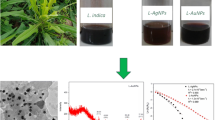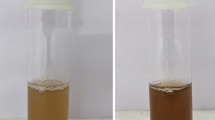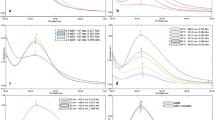Abstract
Plant-derived nanomaterials opened a green approach in solving the current environment issues. Present study focused on rapid microwave-assisted synthesis and applications of gold and silver nanoparticles mediated by aqueous leaf extract of Mussaenda glabrata. The synthesized nanoparticles were characterized by UV-vis, FT-IR, powder XRD, energy-dispersive X-ray spectroscopy (EDX), transmission electron (TEM), and atomic force microscopic techniques (AFM). FCC crystal structure of both nanoparticles was confirmed by peaks corresponding to (111), (200), (220), and (311) planes in XRD spectra and bright circular spots in SAED pattern. IC50 values shown by gold and silver nanoparticles (44.1 ± 0.82 and 57.92 ± 1.33 μg/mL) reflected their high free radical scavenging potential. The synthesized gold and silver nanoparticles revealed their potency to inhibit pathogenic microorganisms Bacillus pumilus, Staphylococcus aureus, Pseudomonas aeruginosa, Escherichia coli, Aspergillus niger, and Penicillium chrysogenum. Anthropogenic pollutants rhodamine B and methyl orange were effectively degraded from aquatic environment and waste water sewages of dye industries using the prepared nanocatalysts. The catalytic capacities of the synthesized nanoparticles were also exploited in the reduction of 4-nitrophenol.

Graphical abstract










Similar content being viewed by others
References
Abbasi E, Milani M, Fekri Aval S et al (2014) Silver nanoparticles: synthesis methods, bio-applications and properties. Crit Rev Microbiol:1–8. doi:10.3109/1040841X.2014.912200
Ahmed S, Ahmad M, Swami BL, Ikram S (2016a) A review on plants extract mediated synthesis of silver nanoparticles for antimicrobial applications: a green expertise. J Adv Res 7:17–28. doi:10.1016/j.jare.2015.02.007
Akter R, Uddin SJ, Grice ID, Tiralongo E (2013) Cytotoxic activity screening of Bangladeshi medicinal plant extracts. J Nat Med 68:246–252. doi:10.1007/s11418-013-0789-5
Alam MN, Bristi NJ, Rafiquzzaman M (2013) Review on in vivo and in vitro methods evaluation of antioxidant activity. Saudi Pharm J 21:143–152. doi:10.1016/j.jsps.2012.05.002
Anastas PT, Kirchhoff MM (2002) Origins, current status, and future challenges of green chemistry†. Acc Chem Res 35:686–694. doi:10.1021/ar010065m
Baghbanzadeh M, Carbone L, Cozzoli PD, Kappe CO (2011) Microwave-assisted synthesis of colloidal inorganic nanocrystals. Angew Chemie - Int Ed 50:11312–11359. doi:10.1002/anie.201101274
Balashanmugam P, Durai P, Balakumaran MD, Kalaichelvan PT (2016) Phytosynthesized gold nanoparticles from C. roxburghii DC. leaf and their toxic effects on normal and cancer cell lines. J Photochem Photobiol B Biol 165:163–173. doi:10.1016/j.jphotobiol.2016.10.013
Balouiri M, Sadiki M, Ibnsouda SK (2016) Methods for in vitro evaluating antimicrobial activity: a review. J Pharm Anal 6:71–79. doi:10.1016/j.jpha.2015.11.005
Baruah B, Gabriel GJ, Akbashev MJ, Booher ME (2013) Facile synthesis of silver nanoparticles stabilized by cationic polynorbornenes and their catalytic activity in 4-nitrophenol reduction. Langmuir 29:4225–4234
Bastús NG, Merkoçi F, Piella J, Puntes V (2014) Synthesis of highly monodisperse citrate-stabilized silver nanoparticles of up to 200 nm: kinetic control and catalytic properties. Chem Mater 26:2836–2846. doi:10.1021/cm500316k
Basu S, Maji P, Ganguly J (2016) Biosynthesis, characterisation and antimicrobial activity of silver and gold nanoparticles by Dolichos biflorus Linn seed extract. J Exp Nanosci 11:660–668. doi:10.1080/17458080.2015.1112042
Benelli G (2015) Plant-mediated biosynthesis of nanoparticles as an emerging tool against mosquitoes of medical and veterinary importance: a review. Parasitol Res 115:23–34. doi:10.1007/s00436-015-4800-9
Bhargava A, Jain N, Khan MA et al (2016) Utilizing metal tolerance potential of soil fungus for efficient synthesis of gold nanoparticles with superior catalytic activity for degradation of rhodamine B. J Environ Manag 183:22–32. doi:10.1016/j.jenvman.2016.08.021
Carlsen MH, Halvorsen BL, Holte K et al (2010) The total antioxidant content of more than 3100 foods, beverages, spices, herbs and supplements used worldwide. Nutr J 9:3. doi:10.1186/1475-2891-9-3
Chang S-T, Wu J-H, Wang S-Y et al (2001) Antioxidant activity of extracts from Acacia confusa bark and heartwood. J Agric Food Chem 49:3420–3424. doi:10.1021/jf0100907
Chung I-M, Park I, Seung-Hyun K et al (2016) Plant-mediated synthesis of silver nanoparticles: their characteristic properties and therapeutic applications. Nanoscale Res Lett 11:40. doi:10.1186/s11671-016-1257-4
Das S, Das J, Samadder A et al (2013) Biosynthesized silver nanoparticles by ethanolic extracts of Phytolacca decandra, Gelsemium sempervirens, Hydrastis canadensis and Thuja occidentalis induce differential cytotoxicity through G2 / M arrest in A375 cells. Colloids Surfaces B Biointerfaces 101:325–336. doi:10.1016/j.colsurfb.2012.07.008
Engelbrekt C, Sørensen KH, Zhang J et al (2009) Green synthesis of gold nanoparticles with starch–glucose and application in bioelectrochemistry. J Mater Chem 19:7839. doi:10.1039/b911111e
Gangula A, Podila RMR et al (2011) Catalytic reduction of 4-nitrophenol using biogenic gold and silver nanoparticles derived from Breynia rhamnoides. Langmuir 27:15268–15274. doi:10.1021/la2034559
Gurunathan S (2014) Rapid biological synthesis of silver nanoparticles and their enhanced antibacterial effects against Escherichia fergusonii and Streptococcus mutans. Arab J Chem. doi:10.1016/j.arabjc.2014.11.014
Hamedi S, Shojaosadati SA, Mohammadi A (2017) Evaluation of the catalytic, antibacterial and anti-biofilm activities of the Convolvulus arvensis extract functionalized silver nanoparticles. J Photochem Photobiol B Biol 167:36–44. doi:10.1016/j.jphotobiol.2016.12.025
Hong X, Wen J, Xiong X, Hu Y (2016) Shape effect on the antibacterial activity of silver nanoparticles synthesized via a microwave-assisted method. Environ Sci Pollut Res 23:4489–4497. doi:10.1007/s11356-015-5668-z
Huo Y, Singh P, Kim YJ et al (2017) Biological synthesis of gold and silver chloride nanoparticles by Glycyrrhiza uralensis and in vitro applications. Artif Cells, Nanomedicine, Biotechnol 4:1–13. doi:10.1080/21691401.2017.1307213
Ibrahim RK, Hayyan M, AlSaadi MA et al (2016) Environmental application of nanotechnology: air, soil, and water. Environ Sci Pollut Res 23:13754–13788. doi:10.1007/s11356-016-6457-z
Jayaseelan C, Ramkumar R, Rahuman AA, Perumal P (2013) Green synthesis of gold nanoparticles using seed aqueous extract of Abelmoschus esculentus and its antifungal activity. Ind Crop Prod 45:423–429. doi:10.1016/j.indcrop.2012.12.019
Jeyapragasam T, Kannan RS (2016) Microwave assisted green synthesis of silver nanorods as catalysts for rhodamine B degradation. Russ J Phys Chem A 90:1334–1337. doi:10.1134/S003602441607030X
Joseph S, Mathew B (2014a) Microwave-assisted facile synthesis of silver nanoparticles in aqueous medium and investigation of their catalytic and antibacterial activities. J Mol Liq 197:346–352. doi:10.1016/j.molliq.2014.06.008
Joseph S, Mathew B (2014b) Microwave assisted biosynthesis of silver nanoparticles using the rhizome extract of Alpinia galanga and evaluation of their catalytic and antimicrobial activities. J Nanoparticles 2014:9. doi:10.1155/2014/967802
Joseph S, Mathew B (2015a) Microwave-assisted green synthesis of silver nanoparticles and the study on catalytic activity in the degradation of dyes. J Mol Liq 204:184–191. doi:10.1016/j.molliq.2015.01.027
Joseph S, Mathew B (2015b) Microwave assisted facile green synthesis of silver and gold nanocatalysts using the leaf extract of Aerva lanata. Spectrochim Acta - Part A Mol Biomol Spectrosc 136:1371–1379. doi:10.1016/j.saa.2014.10.023
Joseph S, Mathew B (2015c) Facile synthesis of silver nanoparticles and their application in dye degradation. Mater Sci Eng B 195:90–97. doi:10.1016/j.mseb.2015.02.007
Kalpanadevi V, Mohan VR (2012) In vitro antioxidant studies of Begonia malabarica Lam. and Begonia floccifera Bedd. Asian Pac J Trop Biomed 2:S1572–S1577. doi:10.1016/S2221-1691(12)60455-9
Kharat SN, Mendhulkar VD (2016) Synthesis, characterization and studies on antioxidant activity of silver nanoparticles using Elephantopus scaber leaf extract. Mater Sci Eng C 62:719–724. doi:10.1016/j.msec.2016.02.024
Kim Y-J, Wang C, Mathiyalagan R et al (2016) Rapid green synthesis of silver and gold nanoparticles using<em> Dendropanax morbifera</em> leaf extract and their anticancer activities. Int J Nanomedicine 11:3691–3701. doi:10.2147/IJN.S97181
Kora AJ, Sashidhar RB, Arunachalam J (2012) Aqueous extract of gum olibanum (Boswellia serrata): a reductant and stabilizer for the biosynthesis of antibacterial silver nanoparticles. Process Biochem 47:1516–1520. doi:10.1016/j.procbio.2012.06.004
Kumar B, Smita K, Cumbal L et al (2016) One pot phytosynthesis of gold nanoparticles using Genipa americana fruit extract and its biological applications. Mater Sci Eng C 62:725–731. doi:10.1016/j.msec.2016.02.029
Lallawmawma H, Sathishkumar G, Sarathbabu S et al (2015) Synthesis of silver and gold nanoparticles using Jasminum nervosum leaf extract and its larvicidal activity against filarial and arboviral vector Culex quinquefasciatus Say (Diptera: Culicidae). Environ Sci Pollut Res 22:17753–17768. doi:10.1007/s11356-015-5001-x
Li L, Hu J, Shi X et al (2016) Nanoscale zero-valent metals: a review of synthesis, characterization, and applications to environmental remediation. Environ Sci Pollut Res 23:17880–17900. doi:10.1007/s11356-016-6626-0
Lim SH, Ahn E-Y, Park Y (2016) Green synthesis and catalytic activity of gold nanoparticles synthesized by Artemisia capillaris water extract. Nanoscale Res Lett 11:474. doi:10.1186/s11671-016-1694-0
Logeswari P, Silambarasan S, Abraham J (2015) Synthesis of silver nanoparticles using plants extract and analysis of their antimicrobial property. J Saudi Chem Soc 19:311–317. doi:10.1016/j.jscs.2012.04.007
Manjari G, Saran S, Arun T et al (2017) Facile Aglaia elaeagnoidea mediated synthesis of silver and gold nanoparticles: antioxidant and catalysis properties. J Clust Sci. doi:10.1007/s10876-017-1199-8
MeenaKumari M, Philip D (2015) Degradation of environment pollutant dyes using phytosynthesized metal nanocatalysts. Spectrochim Acta - Part A Mol Biomol Spectrosc 135:632–638. doi:10.1016/j.saa.2014.07.037
Mittal AK, Chisti Y, Banerjee UC (2013) Synthesis of metallic nanoparticles using plant extracts. Biotechnol Adv 31:346–356. doi:10.1016/j.biotechadv.2013.01.003
Mohanpuria P, Rana NK, Yadav SK (2007) Biosynthesis of nanoparticles: technological concepts and future applications. J Nanopart Res 10:507–517. doi:10.1007/s11051-007-9275-x
Moo-Huchin VM, Moo-Huchin MI, Estrada-León RJ et al (2015) Antioxidant compounds, antioxidant activity and phenolic content in peel from three tropical fruits from Yucatan, Mexico. Food Chem 166:17–22. doi:10.1016/j.foodchem.2014.05.127
MubarakAli D, Thajuddin N, Jeganathan K, Gunasekaran M (2011) Plant extract mediated synthesis of silver and gold nanoparticles and its antibacterial activity against clinically isolated pathogens. Colloids Surfaces B Biointerfaces 85:360–365. doi:10.1016/j.colsurfb.2011.03.009
Mulvaney P (1996) Surface plasmon spectroscopy of nanosized metal particles. Langmuir 12:788–800. doi:10.1021/la9502711
Nimse SB, Pal D (2015) Free radicals, natural antioxidants, and their reaction mechanisms. RSC Adv 5:27986–28006. doi:10.1039/c4ra13315c
Oemrawsingh SSR, Markešević N, Gwinn EG et al (2012) Spectral properties of individual DNA-hosted silver nanoclusters at low temperatures. J Phys Chem C 116:25568–25575. doi:10.1021/jp307848t
Otari S, Patil RM, Nadaf NH et al (2014) Green synthesis of silver nanoparticles by microorganism using organic pollutant: its antimicrobial and catalytic application. Environ Sci Pollut Res 21:1503–1513. doi:10.1007/s11356-013-1764-0
Paul B, Bhuyan B, Purkayastha DD, Dhar SS (2016) Photocatalytic and antibacterial activities of gold and silver nanoparticles synthesized using biomass of Parkia roxburghii leaf. J Photochem Photobiol B Biol 154:1–7. doi:10.1016/j.jphotobiol.2015.11.004
Perugu S, Nagati V, Bhanoori M (2015) Green synthesis of silver nanoparticles using leaf extract of medicinally potent plant Saraca indica: a novel study. Appl Nanosci 6:747–753. doi:10.1007/s13204-015-0486-7
Phull A-R, Abbas Q, Ali A et al (2016) Antioxidant, cytotoxic and antimicrobial activities of green synthesized silver nanoparticles from crude extract of Bergenia ciliata. Futur J Pharm Sci 2:31–36. doi:10.1016/j.fjps.2016.03.001
Prabhu S, Poulose EK (2012) Silver nanoparticles: mechanism of antimicrobial action, synthesis, medical applications, and toxicity effects. Int Nano Lett 2:32. doi:10.1186/2228-5326-2-32
Rai M, Ingle AP, Birla S, et al (2015) Strategic role of selected noble metal nanoparticles in medicine. Crit Rev Microbiol 1–24. doi: 10.3109/1040841X.2015.1018131
Rajan A, Vilas V, Philip D (2015) Studies on catalytic, antioxidant, antibacterial and anticancer activities of biogenic gold nanoparticles. J Mol Liq 212:331–339. doi:10.1016/j.molliq.2015.09.013
Ramakrishna M, Rajesh Babu D, Gengan RM et al (2016) Green synthesis of gold nanoparticles using marine algae and evaluation of their catalytic activity. J Nanostructure Chem 6:1–13. doi:10.1007/s40097-015-0173-y
Ramamurthy C, Padma M, Mariya Samadanam ID et al (2013) The extra cellular synthesis of gold and silver nanoparticles and their free radical scavenging and antibacterial properties. Colloids Surfaces B Biointerfaces 102:808–815. doi:10.1016/j.colsurfb.2012.09.025
Rathi Sre PR, Reka M, Poovazhagi R et al (2015) Antibacterial and cytotoxic effect of biologically synthesized silver nanoparticles using aqueous root extract of Erythrina indica lam. Spectrochim Acta - Part A Mol Biomol Spectrosc 135:1137–1144. doi:10.1016/j.saa.2014.08.019
Seralathan J, Stevenson P, Subramaniam S et al (2014) Spectroscopy investigation on chemo-catalytic, free radical scavenging and bactericidal properties of biogenic silver nanoparticles synthesized using Salicornia brachiata aqueous extract. Spectrochim Acta - Part A Mol Biomol Spectrosc 118:349–355. doi:10.1016/j.saa.2013.08.114
Shahidi F, Ambigaipalan P (2015) Phenolics and polyphenolics in foods, beverages and spices: antioxidant activity and health effects—a review. J Funct Foods 18:820–897. doi:10.1016/j.jff.2015.06.018
Shashirekha MN, Mallikarjuna SE, Rajarathnam S (2013) Status of bioactive compounds in foods, with focus on fruits and vegetables. Crit Rev Food Sci Nutr 55:1324–1339. doi:10.1080/10408398.2012.692736
Sheldon RA (2012) Fundamentals of green chemistry: efficiency in reaction design. Chem Soc Rev 41:1437–1451. doi:10.1039/c1cs15219j
Subbaiah MV, Kim D-S (2016) Adsorption of methyl orange from aqueous solution by aminated pumpkin seed powder: kinetics, isotherms, and thermodynamic studies. Ecotoxicol Environ Saf 128:109–117. doi:10.1016/j.ecoenv.2016.02.016
Sujitha MV, Kannan S (2013) Green synthesis of gold nanoparticles using citrus fruits (Citrus limon, Citrus reticulata and Citrus sinensis) aqueous extract and its characterization. Spectrochim Acta - Part A Mol Biomol Spectrosc 102:15–23. doi:10.1016/j.saa.2012.09.042
Swamy MK, Akhtar MS, Mohanty SK, Sinniah UR (2015) Synthesis and characterization of silver nanoparticles using fruit extract of Momordica cymbalaria and assessment of their in vitro antimicrobial, antioxidant and cytotoxicity activities. Spectrochim Acta Part A Mol Biomol Spectrosc 151:939–944. doi:10.1016/j.saa.2015.07.009
Tong L, Chuang C-C, Wu S, Zuo L (2015) Reactive oxygen species in redox cancer therapy. Cancer Lett 367:18–25. doi:10.1016/j.canlet.2015.07.008
Varadavenkatesan T, Selvaraj R, Vinayagam R (2016) Phyto-synthesis of silver nanoparticles from Mussaenda erythrophylla leaf extract and their application in catalytic degradation of methyl orange dye. J Mol Liq 221:1063–1070. doi:10.1016/j.molliq.2016.06.064
Vidhu VK, Philip D (2014) Catalytic degradation of organic dyes using biosynthesized silver nanoparticles. Micron 56:54–62. doi:10.1016/j.micron.2013.10.006
Vidyalakshmi KS, Vasanthi HR, Rajamanickam G V (2008) Ethnobotany, phytochemistry and pharmacology of Mussaenda species (Rubiaceae). Ethnobot Leafl 12:469–475.
Vilas V, Philip D, Mathew J (2016) Essential oil mediated synthesis of silver nanocrystals for environmental, anti-microbial and antioxidant applications. Mater Sci Eng C 61:429–436. doi:10.1016/j.msec.2015.12.083
Wilhelm P, Stephan D (2007) Photodegradation of rhodamine B in aqueous solution via SiO2@TiO2 nano-spheres. J Photochem Photobiol A Chem 185:19–25. doi:10.1016/j.jphotochem.2006.05.003
Yu J, Xu D, Guan HN et al (2016) Facile one-step green synthesis of gold nanoparticles using Citrus maxima aqueous extracts and its catalytic activity. Mater Lett 166:110–112. doi:10.1016/j.matlet.2015.12.031
Acknowledgements
The financial assistance to Sijo Francis from University Grants Commission (under Faculty Development Programme), Government of India, is gratefully acknowledged.
Author information
Authors and Affiliations
Corresponding author
Ethics declarations
Conflict of interest
The authors declare that they have no conflict of interest.
Additional information
Responsible editor: Suresh Pillai
Highlights
• Gold and silver nanoparticles by easily mastered green microwave procedure.
• Triangular and spherical gold nanoparticles and quasi-spherical silver nanoparticles offer a new hope in water purification because of their excellent antimicrobial capacity.
• Antioxidant and antimicrobial efficacy increase their pharmaceutical value.
• Control of the environmental pollution utilizing the catalytic power of metal nanoparticles.
• Effective catalysts in the degradation of dyes.
Rights and permissions
About this article
Cite this article
Francis, S., Joseph, S., Koshy, E.P. et al. Green synthesis and characterization of gold and silver nanoparticles using Mussaenda glabrata leaf extract and their environmental applications to dye degradation. Environ Sci Pollut Res 24, 17347–17357 (2017). https://doi.org/10.1007/s11356-017-9329-2
Received:
Accepted:
Published:
Issue Date:
DOI: https://doi.org/10.1007/s11356-017-9329-2




